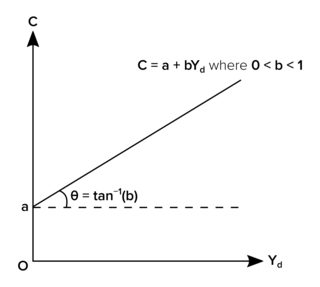Jet lag is a physiological condition which results from alterations to the body's circadian rhythms caused by rapid long-distance trans-meridian travel. For example, someone flying from New York to London, i.e. from west to east, feels as if the time were five hours earlier than local time, and someone travelling from London to New York, i.e. from east to west, feels as if the time were five hours later than local time. Jet lag was previously classified as one of the circadian rhythm sleep disorders.

In economics and political science, fiscal policy is the use of government revenue collection and expenditure (spending) to influence the economy. According to Keynesian economics, when the government changes the levels of taxation and government spending, it influences aggregate demand and the level of economic activity. Fiscal policy is often used to stabilize the economy over the course of the business cycle.

A consumer price index (CPI) measures changes in the price level of market basket of consumer goods and services purchased by households.
In economics, time preference is the current relative valuation placed on receiving a good at an earlier date compared with receiving it at a later date.

The French paradox is a catchphrase, first used in the late 1980s, that summarizes the apparently paradoxical epidemiological observation that French people have a relatively low incidence of coronary heart disease (CHD), while having a diet relatively rich in saturated fats, in apparent contradiction to the widely held belief that the high consumption of such fats is a risk factor for CHD. The paradox is that if the thesis linking saturated fats to CHD is valid, the French ought to have a higher rate of CHD than comparable countries where the per capita consumption of such fats is lower.
The lunitidal interval, measures the time lag from the Moon passing overhead, to the next high or low tide. It is also called the high water interval (HWI). Sometimes a term is not used for the time lag, but instead the terms age of the tide or the establishment of the tide are used for the entry that is in the tidal tables.
In the study of dynamical systems, a delay embedding theorem gives the conditions under which a chaotic dynamical system can be reconstructed from a sequence of observations of the state of a dynamical system. The reconstruction preserves the properties of the dynamical system that do not change under smooth coordinate changes, but it does not preserve the geometric shape of structures in phase space.
Seasonal lag is the phenomenon whereby the date of maximum average air temperature at a geographical location on a planet is delayed until some time after the date of maximum insolation. This also applies to the minimum temperature being delayed until some time after the date of minimum insolation.
In photography, shutter lag is the delay between triggering the shutter and when the photograph is actually recorded. This is a common problem in the photography of fast-moving objects or people in motion. The term narrowly refers only to shutter effects, but more broadly refers to all lag between when the shutter button is pressed and when the photo is taken, including metering and focus lag.
The term cultural lag refers to the notion that culture takes time to catch up with technological innovations, and that social problems and conflicts are caused by this lag. Subsequently, cultural lag does not only apply to this idea only, but also relates to theory and explanation. It helps by identifying and explaining social problems to predict future problems.

Armodafinil is the enantiopure compound of the eugeroic modafinil (Provigil). It consists of only the (R)-(−)-enantiomer of the racemic modafinil. Armodafinil is produced by the pharmaceutical company Cephalon Inc. and was approved by the U.S. Food and Drug Administration (FDA) in June 2007. In 2016, the FDA granted Mylan rights for the first generic version of Cephalon's Nuvigil to be marketed in the U.S.

A heat detector is a fire alarm device designed to respond when the convected thermal energy of a fire increases the temperature of a heat sensitive element. The thermal mass and conductivity of the element regulate the rate flow of heat into the element. All heat detectors have this thermal lag. Heat detectors have two main classifications of operation, "rate-of-rise" and "fixed temperature". The heat detector is used to help in the reduction of damaged property. It is triggered when temperature increases.
Lag refers to slower response time, and to delays experienced in computing, communications, and engineering.
Advertising adstock is a term coined by Simon Broadbent to describe the prolonged or lagged effect of advertising on consumer purchase behavior. It is also known as 'advertising carry-over'. Adstock is an important component of marketing-mix models.

The flash lag illusion or flash-lag effect is a visual illusion wherein a flash and a moving object that appear in the same location are perceived to be displaced from one another). Several explanations for this simple illusion have been explored in the neuroscience literature.
In online gaming, lag is a noticeable delay between the action of players and the reaction of the server supporting the game.
Display lag is a phenomenon associated with some types of liquid crystal displays (LCDs) like smartphones and computers, and nearly all types of high-definition televisions (HDTVs). It refers to latency, or lag measured by the difference between the time there is a signal input, and the time it takes the input to display on the screen. This lag time has been measured as high as 68 ms, or the equivalent of 3-4 frames on a 60 Hz display. Display lag is not to be confused with pixel response time. Currently the majority of manufacturers do not include any specification or information about display latency on the screens they produce.
The expression cultural jet lag was first coined by Marc Perraud during his research into cross-cultural psychology. He describes the expression as the phenomenon of partial socialization in adults born from bi-cultural/national unions and whose childhood was characterized by nomadic displacement during key personality developmental stages. Jet symbolically designates international travel as the cause, cultural lag the resulting disconnect observed in these patients.
The general use of the phrase ‘input lag’ is used to describe the delay between an electrical input from the point of stimulation to action, for example, pressing a button and seeing the event after as little as 1/24th of a second.
In international finance, leads and lags refer to the expediting or delaying, respectively, of settlement of payments or receipts in a foreign exchange transaction because of an expected change in exchange rates. A change in exchange rates can be a cause of loss in international trade, thus the settlement of debts is expedited or delayed in an attempt to minimize the loss or to maximize the gain. In the leads and lags, the premature payment for goods purchased is called a "lead," while the delayed payment is called a "lag."






